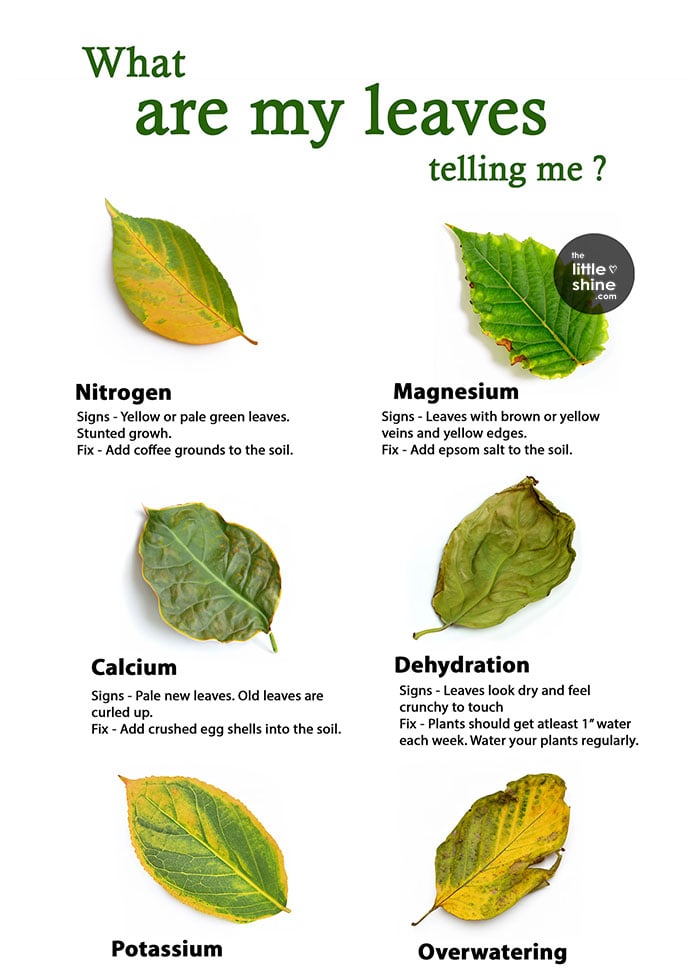If you’re a plant lover and off-late you’ve noticed some of your previously healthy plants, have their leaves turning yellowish brown. Well, I’m sure that would be rather unsettling for you to see and will get you wondering why, right?

Is it because of the lack or excess of sunlight? Or maybe the lack or excess of water? Well, the reasons can be those and many others including nutrient deficiencies, pest problems and more.
Let’s get into more details on what leaves say about your plants and how you can fix these issues!
6 Ways Leaves Talk about Your Plant Issues and How to Fix Them
1. Pest Issues
With this issue, you may find insects eating the leaves or living on them. All you need to do is spray your plant with some neem oil or you could even use an insecticide spray.
2. Plant Dehydration or Lack of Watering
If you find that the leaves look dry and on the touch, they feel dry and crisp, then your plant is dehydrated. This means you will need to water that particular plant more often.
So, in case you have been watering it just once a day, you will need to water it a second time.
3. Overwatering or Excessive Watering
If you see that your leaves have turned yellow and they look dull and wilted, then your plant has been overwatered. This could also mean that your pot doesn’t have proper drainage holes and there is root rotting.
You can add more soil or repot the plant and reduce watering it (by either skipping a day in between (until it rejuvenates) or by watering it with less water every day).
4. Lack of Sunlight
If your leaves look droopy and begin to fade, then your plant is lacking sunlight. This means that the leaves aren’t getting enough exposure to sunlight and you will need to reposition your plant in a well-sunlit area.
5. Dehydration
Your leaves look dry and crunchy to the touch. This means that the leaves aren’t getting enough water and you need to rehydrate it.
Water your plants regularly. Make sure to use at least 1″ of water every week.
6. Excessive exposure to Sunlight
If your leaves are turning brown and feel crisp and pale, then it could be because they are exposed to too much sunlight. Therefore, repositioning your plant for a week or so, and keeping it away from direct sunlight could help reduce the overexposure.
6. Nutrient Deficiencies
Nitrogen Deficiency: You will begin to notice that the center vein and the tips become yellow of the leaves in plants that have nitrogen deficiency. You can add an organic compost like coffee grounds or manure to the soil. Add coffee grounds directly to the top of your garden soil or simply sprinkling the grounds on top. However, make sure the layer in no thicker than 1/2 inch.
Magnesium Deficiency: When the leaves show signs of white stripes along the veins, then the plant is magnesium deficient and you will need to add an organic compost that is rich in magnesium. You can also add epsom salt to the soil, take 1-2 tsp of Epsom salt & sprinkle around the plant; mix the soil a little and then water.
Iron Deficiency: If you notice that the leaves have become yellow and have very light and small green colored veins, then your plant is iron deficient. You can then determine the pH level of your soil and thereafter, lower the levels of phosphorous in the soil of that particular plant/pot.
Zinc Deficiency: When the leaves of your plant show some signs of light discoloration in between their large veins, then the plant is zinc deficient. You can spray the plant with some kelp extract to reduce this issue.
Calcium Deficiency: You may observe that the leaves of the plant have become misshapen. This means the plant is calcium deficient and you will have to check whether your soil is acidic or alkaline. If the is acidic, use lime and if it is alkaline, use gypsum to solve this issue.
Potassium Deficiency: When your plant has a potassium deficiency, the leaves will become yellow, but only at the edges and the tips. You can thereby add in some compost that is rich in fruit and vegetable waste. Bury banana peel in the soil or make banana peel water as banana peels contain lots of potassium.